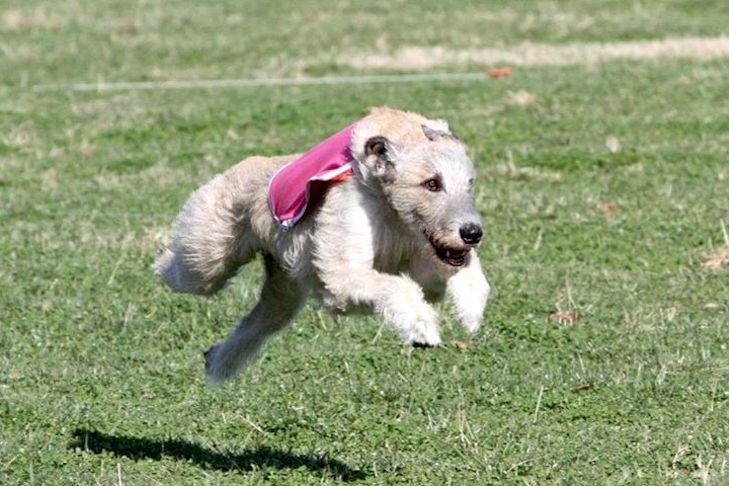
The Irish Wolfhound is an ancient and giant breed. These tall, muscular dogs can weigh as much as 180 pounds and can stand as tall as seven feet when up on their hind legs. They have a strong instinct to hunt, which makes them a wonderful candidate for AKC sports like tracking, agility, and lure coursing. When training Irish Wolfhounds, it’s important to focus on their unique skills and personalities.
Jennifer Ahrens knows a lot about training Irish Wolfhounds — she’s had the breed for more than 15 years.
She Studied the Iditarod When Preparing for Lure Coursing
Lure Coursing is one of the action-packed sports that Ahrens focuses on with her Irish Wolfhounds. This sport, open only to a select few breeds, tests the inherent coursing characteristics of sighthounds in a safe, controlled environment.
Ahrens spent a lot of time researching while training her dog, Sean, so she could make sure she took the best approach in everything she did.
“I can tell you that he had extensive training,” she said. “I even studied how they trained dogs for the Iditarod to condition Sean for lure coursing.”
The Iditarod is an annual long-distance sled dog race from Anchorage to Nome that takes place every March. She said that while she was studying up on coursing, she realized that there weren’t many books on how to condition dogs for sports.
“I ended up studying Olympic athletics and Iditarod dogs and their humans,” she said. “I applied that knowledge and found what worked for my dog.”
Part of Sean’s training included a two- to three-mile brisk run and walk every day.
“I would run him up and down hills and also in the water.”
Focus on Paws, Nails, & Warming Up
For Ahrens, conditioning included a focus on Sean’s paws and nails, using paw protector and mineral oil.
Another big part of training involved the warmup. “I always warmed up his muscles walking, and massaged him before and after the runs, and then also walking him out afterward,” she said.

Specially Timed Meals Are Important
Mealtimes were part of Sean’s training, too. Ahrens fed him a raw diet mixed with kibble. Because they traveled a lot, the kibble helped keep his stomach from getting upset.
“I made sure to feed him a light meal over an hour before the event so he would have energy,” she said. “I was a crazy lure coursing dog mom.”
She said she even made a special muzzle for Sean to supply him with extra air during his competitions when they traveled to Colorado.
“I wrapped a regular muzzle in Cellophane wrap, made two air holes for the cannula, wrapped the cannula onto the muzzle and secured it with packing tape, and hooked him up to oxygen,” she recalled. “Muscles need to … replenish the oxygen used in exercise. It probably wasn’t needed. But he accepted it and it made me feel better… I felt that I was doing something for him. I got the idea to do that from watching the football players take oxygen on the sidelines after a play.”
Focus on a Wolfhound’s Prey Drive
One important thing to keep in mind, Ahrens said, is that Irish Wolfhounds often have a shorter attention span than other dogs.
“They won’t practice to please you,” she said. “They must want to do it and see fun in it. You have to motivate these guys so they channel their prey drive.”
She also brought a foldable “stretcher” with her to all competitions in case of emergencies. It would help make it easier to carry Sean if something were to happen, since Wolfhounds are so large.
Ultimately, Ahren’s focus was on Sean’s safety first and foremost.
“While I will say it was a great feeling to win, it was a greater feeling that my dog didn’t come off the field lame, limping, or with any injuries,” she said. “I do believe it is because we both worked as a team and put our ‘all’ into it.” Dogs in general are easy to train as long as they enjoy what they’re doing, she added.
“Dogs want self-gratification, to please themselves and also their humans,” she said. “They live for that human interaction. And just like us, they want to be needed and relevant. I think that dogs are easy to train when you find something that they like to do.”

